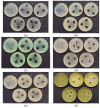Antimicrobial Properties of Newly Developed Silver-Enriched Red Onion-Polymer Composites
- PMID: 38786169
- PMCID: PMC11117916
- DOI: 10.3390/antibiotics13050441
Antimicrobial Properties of Newly Developed Silver-Enriched Red Onion-Polymer Composites
Abstract
Simple low-cost, nontoxic, environmentally friendly plant-extract-based polymer films play an important role in their application in medicine, the food industry, and agriculture. The addition of silver nanoparticles to the composition of these films enhances their antimicrobial capabilities and makes them suitable for the treatment and prevention of infections. In this study, polymer-based gels and films (AgRonPVA) containing silver nanoparticles (AgNPs) were produced at room temperature from fresh red onion peel extract ("Ron"), silver nitrate, and polyvinyl alcohol (PVA). Silver nanoparticles were synthesized directly in a polymer matrix, which was irradiated by UV light. The presence of nanoparticles was approved by analyzing characteristic local surface plasmon resonance peaks occurring in UV-Vis absorbance spectra of irradiated experimental samples. The proof of evidence was supported by the results of XRD and EDX measurements. The diffusion-based method was applied to investigate the antimicrobial activity of several types of microbes located in the environment of the produced samples. Bacteria Staphylococcus aureus ATCC 29213, Acinetobacter baumannii ATCC BAA 747, and Pseudomonas aeruginosa ATCC 15442; yeasts Candida parapsilosis CBS 8836 and Candida albicans ATCC 90028; and microscopic fungi assays Aspergillus flavus BTL G-33 and Aspergillus fumigatus BTL G-38 were used in this investigation. The greatest effect was observed on Staphylococcus aureus, Acinetobacter baumannii, and Pseudomonas aeruginosa bacteria, defining these films as potential candidates for antimicrobial applications. The antimicrobial features of the films were less effective against fungi and the weakest against yeasts.
Keywords: films; gels; nanoparticles; peel; polyvinyl alcohol; red onion; silver.
Conflict of interest statement
The authors declare no conflicts of interest.
Figures








Similar articles
-
Application of Red Onion Peel Extract for Green Synthesis of Silver Nanoparticles in Hydrogels Exhibiting Antimicrobial Properties.Gels. 2023 Jun 19;9(6):498. doi: 10.3390/gels9060498. Gels. 2023. PMID: 37367169 Free PMC article.
-
Antimicrobial and Cytotoxicity Effects of Synthesized Silver Nanoparticles from Punica granatum Peel Extract.Nanoscale Res Lett. 2018 Oct 4;13(1):315. doi: 10.1186/s11671-018-2731-y. Nanoscale Res Lett. 2018. PMID: 30288618 Free PMC article.
-
Phytosynthesis via wasted onion peel extract of samarium oxide/silver core/shell nanoparticles for excellent inhibition of microbes.Heliyon. 2024 Jan 20;10(3):e24815. doi: 10.1016/j.heliyon.2024.e24815. eCollection 2024 Feb 15. Heliyon. 2024. PMID: 38322933 Free PMC article.
-
Green Synthesis of Silver Nanoparticles Using Aerial Part Extract of the Anthemis pseudocotula Boiss. Plant and Their Biological Activity.Molecules. 2022 Dec 28;28(1):246. doi: 10.3390/molecules28010246. Molecules. 2022. PMID: 36615440 Free PMC article.
-
Comparison of Antimicrobial Properties of Silver Nanoparticles Synthesized from Selected Bacteria.Indian J Microbiol. 2018 Sep;58(3):301-311. doi: 10.1007/s12088-018-0723-3. Epub 2018 Apr 5. Indian J Microbiol. 2018. PMID: 30013274 Free PMC article.
Cited by
-
Silver and Gold Compounds as Antibiotics.Antibiotics (Basel). 2024 Sep 5;13(9):850. doi: 10.3390/antibiotics13090850. Antibiotics (Basel). 2024. PMID: 39335023 Free PMC article.
References
-
- Chassagne F., Samarakoon T., Porras G., Lyles J.T., Dettweiler M., Marquez L., Salam A.M., Shabih S., Farrokhi D.R., Quave C.L. A Systematic Review of Plants with Antibacterial Activities: A Taxonomic and Phylogenetic Perspective. Front. Pharmacol. 2021;11:586548. doi: 10.3389/fphar.2020.586548. - DOI - PMC - PubMed
-
- Ye C.L., Dai D.H., Hu W.L. Antimicrobial and antioxidant activities of the essential oil from onion (Allium cepa L.) Food Control. 2013;30:48–53. doi: 10.1016/j.foodcont.2012.07.033. - DOI
LinkOut - more resources
Full Text Sources
Molecular Biology Databases
Miscellaneous

